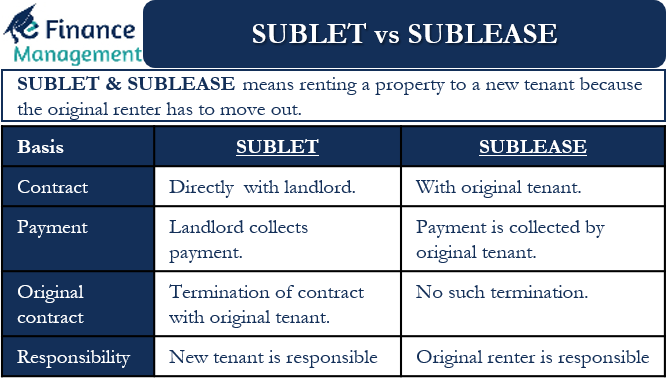Sublet and Sublease are terms that we generally come across in rental or lease agreements. The two terms are often interchangeable; in reality, the two terms are very different. And can have huge financial implications if you fail to understand them correctly. To understand these two terms clearly, we need to know the differences between Sublet vs Sublease.
Both Sublets vs Sublease means renting a property to a new tenant. However, the difference between subletting and subleasing lies primarily in the role of the original tenant. In both Sublets vs Sublease, a property is rented to a new tenant because the original tenant has to move out. However, who gives the property on rent to the new tenant and who is responsible for the property and collecting the rent distinguishes subletting from subleasing.
There may be several reasons why the original tenant would have to move out before the expiry of the lease. These reasons could be job transfers, the birth of a child, and much more. Regardless of the reason for terminating the lease, it is important that this is done with the consent of both parties.
Usually, the original lease agreement carries the provision of whether a tenant can sublet or sublease the property. So, when we sign a rental agreement, it is important that we make the sublet or sublease thing clear with the landlord.
Also Read: Sublease
Sublet vs Sublease – Differences
The differences between subletting and subleasing are as follows:
- In the case of subletting, a new tenant is in direct contact with the landlord. In a sublease, the original tenant leases out the property in whole or in part to a new tenant.
- The landlord drafts a new rental agreement with the new tenant in a sublet (or relet). In a subleasing agreement, it is the original tenant who contracts with the new tenant whom he is subleasing.
- The landlord collects the rent or lease payment directly from the new tenant under the sublet. In a sublease, the original tenant collects the rent and then passes it on to the landlord, depending on the agreement. It is possible that the original tenant may pocket money from subleasing in terms of the original leasing agreement.
- In the case of subletting, the landlord can terminate the rent agreement with the original tenant, and the sublet agreement can still continue. However, there is no such thing in the sublease. If the original lease is coming to an end, the sub-lease will also automatically come to an end.
- In the case of subletting, the new tenant (sublet part) is responsible for the property. But, in a sublease, the responsibility for the rental unit/property remains with the original lessee. This means that the original tenant/first lessee will be held accountable for any damage to the rental unit/leased property though there is a sub-lease. Therefore, it is very important for the original lessee to properly screen the new tenant (sublessee) before entering into the sublease.
It should be noted that both sublet and sublease can be of full or partial property. Even if the sublet or sublease is of part property, the rules and responsibilities for the original and new tenant will remain the same.

Sublease vs Sublet – Which is Better?
Sublease and sublet generally come into play when the original tenant plans to move out between the rental/lease periods. From the original tenant’s point of view, subletting is a good option if:
- They had to move out and find someone to sign a new contract with the landlord. Doing this relieves the original tenant from certain financial and legal obligations on account of sublet arrangements.
- Subleasing is good if you plan to sublease only part of the property. If the original lessee has enough space for themselves, then subleasing is a good option. This could help the original tenant/lessee save or make some money. However, it is important that the original renter should retain a trusted subtenant. And the original lessee should be expected to stay till the expiry of the original lease.
- If you can’t sublet because the landlord doesn’t want to, or if you can’t find the right tenant, then subleasing is the only option available to optimize the use of the property and generate some income out of it.
Final Words
Before agreeing to sublet or sublease, it is important that you obtain the consent of the landlord. Also, check your renter’s insurance policy. Some insurance companies do not cover a renter if they sublease some portion of the property. In addition, you must check local laws governing subletting and subleasing conditions.
Frequently Asked Questions (FAQs)
Subletting is an agreement between the landlord and the new tenant in case the original tenant has to move out before the expiry of the contract.
Also Read: Freehold vs Leasehold
Since the subletting agreement is between the landlord and the new tenant, the latter is responsible for damage to the property.
While entering into a rental agreement, the tenant can clarify the conditions for subletting the property with the landlord and can include a clause in the agreement for the same. Then subletting will remain legal.
Subletting property is better from the point of view of the original tenant, as he gets discharge from the responsibilities.

